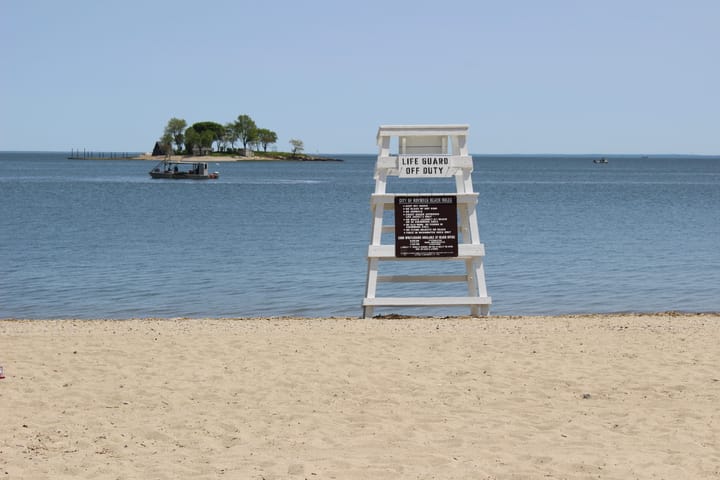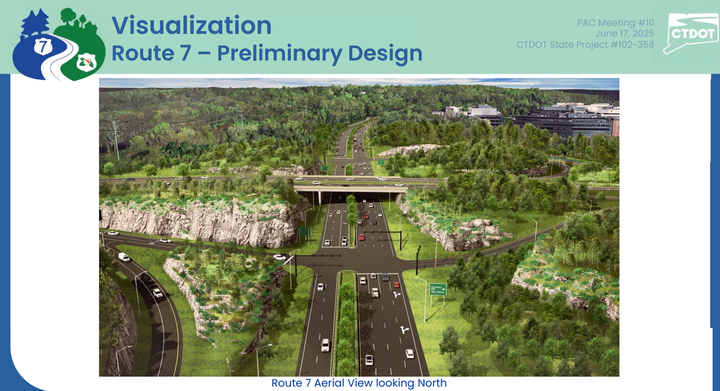How I-95 Construction Projects Could Impact The Region
Three I-95 construction projects could impact several areas of our region including: Norwalk to Westport and Greenwich to Stamford.

I-95 is one of the largest highways in the country, spanning the East Coast from Maine in the north to Miami, Florida in the south. The 25+ mile section of I-95 that passes through our region, from the New York State border through Fairfield, is one of the most traveled.
“More than a dozen mainline locations experience more than 160,000 vehicles on an average weekday and occur within Greenwich, Stamford, Darien, Norwalk, and Bridgeport with somewhat lower volumes occurring through Westport, Fairfield, Stratford, Orange, Milford and West Haven,” a 2016 DOT study of I-95 congestion found. In 2015, the Darien and Norwalk areas saw more than 180,000 vehicles a day, according to a congestion report from WestCog, a regional planning authority. While the pandemic reduced the number of cars on the road, traffic is back on the rise.
With all of that use, the road needs a variety of improvements and additions to make sure it stays safe and usable for those who travel on it. However, because it’s such a popular travel option, any construction projects cause a significant impact on the area.
Norwalk-Westport Project
Just a few weeks ago, an approximately $100 million project kicked off between Norwalk and Westport, stretching from exit 16 to past exit 17.
The project, which was outlined at a public hearing in June 2021, has multiple components, according to Brett Stark, who is a contractor from BL Companies serving as the program manager, which include:
- Reconstruction of the median
- Widening the shoulders
- Extending the on-ramp coming from Exit 16
- Replacing one bridge and rehabilitating two others
- Paving and resurfacing the entire stretch
- Improving drainage in the area
- Replacing the highway lighting system
- Reconstructing the commuter parking lot off of Hendricks Avenue in Norwalk
One of the safety features Stark highlighted included the extension of the exit 16 on-ramp onto I-95 North.
“As drivers accelerate along the ramp from East Avenue…this condition has precipitated a number of crashes,” he said. “(The) on-ramp will be extended to provide a parallel merge for 1,050 feet.”
The biggest portion of the project is the replacing of the I-95 bridge over Saugatuck Avenue.
The portions of the bridge will be moved into place through a “lateral slide” method, Stark said, and the bridge itself will now be wider to allow for the new 12-foot shoulders along I-95.
When the parts of the bridge are ready to be moved into place, the on and off ramps will be closed, and the lanes of I-95 will be crossed over to the opposite side. For example, when the southbound I-95 portion is ready, two northbound I-95 lanes will be shifted over (including onto the shoulder) to allow for two southbound lanes on that side of the span while the portion of the bridge is put into place. The same will happen for the northbound side.
The bridge replacement is projected to take place in fall 2023 over two, nonconsecutive weekends.
The goals of the project, according to Stark, include:
- enhancing safety for motorists and commuters
- upgrading the roadway to meet current standards—particularly widening the median and shoulders
- addressing drainage issues and flooding problems
- improving rideability with the new pavement and lighting
Stark called it “a safety improvement project.”
Throughout the project, during peak hours, the same number of three lanes in each direction will be maintained, but during off-peak hours there will be some lane closures, beginning this July.
“If you’ve ever been traveling I-95 in the vicinity of exit 16 during a heavy rainstorm, you may have noticed the tendency of water to pond up in the outside shoulder,” he said.
That’s in part because the “existing drainage is undersized,” Stark said, so this project will also install a supplemental system to make sure the flooding doesn’t occur as much.
One thing the project doesn’t include are new sound barriers, something the East Norwalk Neighborhood Association questioned at the June 2021 hearing.
“Why can’t state funds be used to finally install sound barriers for the missing highway portion in Norwalk?” the association asked.
Stark responded that “the allocation of state funds for new noise barriers at a new location requires an act by the State legislature. A local legislator must be the one to initiate the request, it is not the matter of DOT requesting the funds.”
The project is scheduled to run through fall 2024, or about “three seasons of work,” according to Stark.
One of the biggest challenges with this project is making sure it doesn’t impact the other ongoing projects in the area.
“It is recognized that it will be one of several ongoing or planned projects in this region of the state,” Stark said, specifically noting the Merritt Parkway and Walk Bridge construction projects.
Yankee Doodle Comes to a Close
As the Norwalk-Westport project kicks off, the repair project on the Yankee Doodle Bridge in Norwalk is starting to wrap up.
The project ran two years over schedule, in part due to additional steel support work that was found when work began, CTDOT spokesman Josh Morgan said.
“It did go two years over, it did increase in cost as well, and this was a bridge repair, concrete repair,” he said. “A lot of the work ended up being more extensive and expansive than originally planned—the steel repair went from approximately 90 locations to 450 locations.”
John Deliberto, a transportation supervising engineer at CTDOT, called the Yankee Doodle Bridge a “rare case” at the June 2021 public hearing.
“We really didn't know the nature of the deterioration unless the contractor got in there and removed some of the rust,” he said. “That led to really a complete redesign of the repairs.”
Morgan said the project will be wrapping up by the end of this summer and is in the final phase, but noted there would be some lane closures in late July to bolt in the concrete medians.
“So those have to get taken out, removed, and then there’s milling and paving that has to happen,” he said.
Morgan said when the work is complete the hope is that traffic will be able to flow better.
“Hopefully, traffic can travel through the bridge in that area a little more smoothly,” he said.
Just Paving, For Now, in Greenwich and Stamford
The biggest proposed project for I-95, which totaled more than $200 million in work from the Connecticut border to exit 6, is getting a second look after local officials and residents raised questions about the project.
“That entire scope is being revisited,” Morgan said.
In April, Governor Ned Lamont asked the CTDOT to “take another look” at the proposal which called for road resurfacing, bridge rehabilitation, drainage work, lighting, and safety improvements along the stretch of highway.
“Governor Lamont has informed me that he has directed the DOT to withdraw the current project and to revisit it to develop a more comprehensive project solution," Greenwich First Selectman Fred Camillo said in an April statement. "I am pleased that the grassroots efforts of our residents, along with the collaboration of our legislative delegation and Department of Public Works, were successful. We were able to show the State that there was a need for a more comprehensive plan to mitigate the noise generated by highway traffic which has a negative impact on our residents and environment."
Residents, such as the Riverside Association in Greenwich, argued that the project did nothing to “address noise pollution from I-95 that disrupts sleep, reduces property values, and adversely impacts our health.”
Morgan said the department is currently doing a PEL—planning and environmental linkage—study of the project which will take a few years to complete.
“That’s looking at transportation needs, community needs, economic development,” he said. “It usually involves community stakeholders through a project advisory committee, which could involve elected officials, Chamber of Commerce, community stakeholders, business groups—so that takes many years.”
Morgan said this will also allow the DOT to review “what’s possible, what’s feasible, what makes the most sense for that area.”
In the meantime, Morgan said that the state is planning to do some paving work in the area in the interim over the next two years.
“So the pavement rehabilitation—it won’t be as extensive as what was planned as the original project,” he said.
He described it as “mill and fill” where three inches or so are removed from the roadway and new asphalt is laid on top of that to create a smoother drive from the state line to exit 6.
“That will improve road conditions, because the pavement conditions there are not in great shape, so this is sort of an interim project,” he said.
The pavement project will allow the roadway to operate as smoothly as possible while the state awaits the results of the PEL study, he said.
Keep an Eye Out on the Roads
With all these projects, Morgan and other officials ask residents to be cautious moving through work areas to help ensure the safety of both drivers and those constructing the projects.
“Remind motorists to slow down in work zones—pay attention, slow down anywhere in the state,” he said. “We want to keep them safe. We want to keep our workers and our contractors safe.”
Overnight lane closures for the Norwalk-Westport project will begin mid-July, while the paving work in Greenwich and Stamford will begin in the fall.



